Vue3 + Js + Element-Plus + VueX后台管理系统通用解决方案
前言
本文是作为学习总结而写的一篇文章,也是方便以后有相关需求,可以直接拿来用,也算是记录吧,文中有一些文件的引入,没给出来,完整项目地址(后续代码仓库放这里)
1、layout解决方案
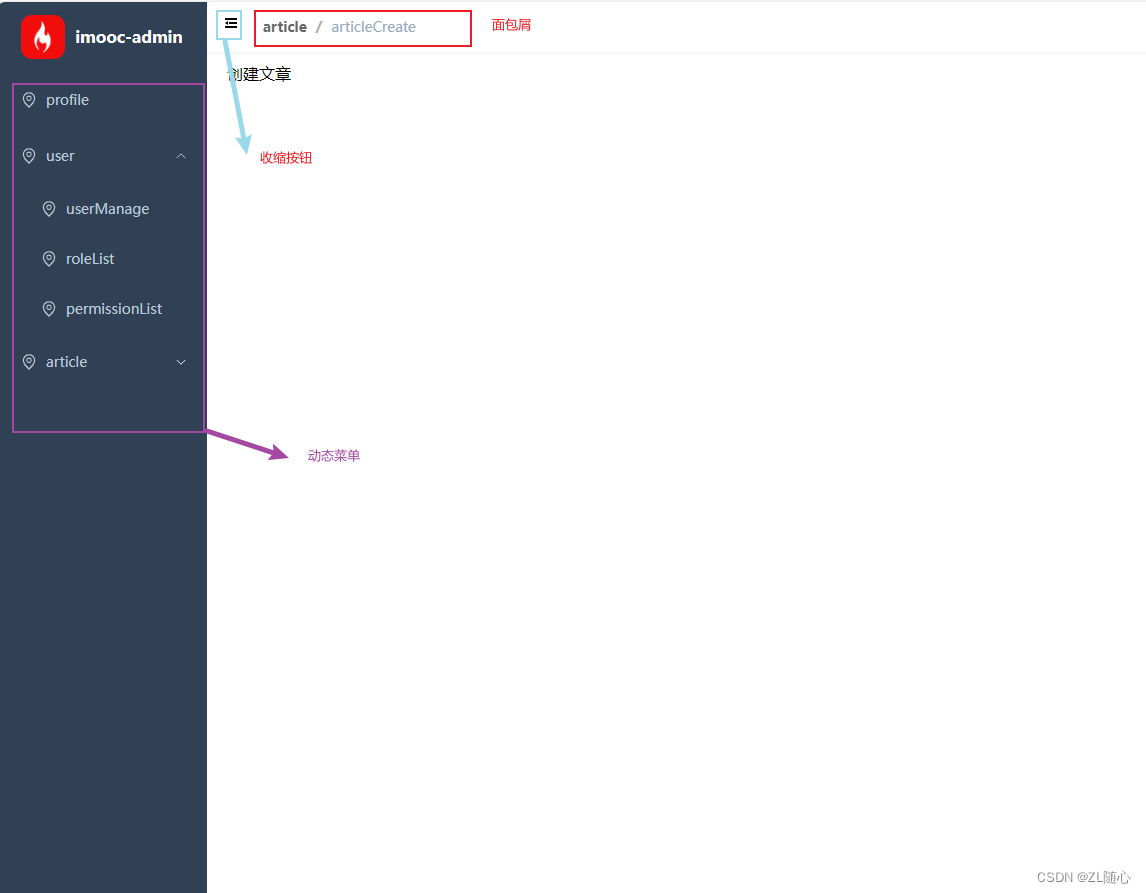
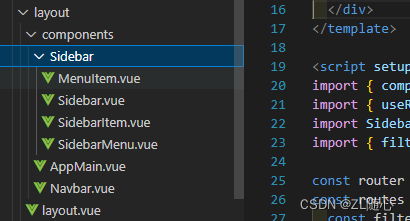
1.1、动态菜单
左侧整体文件 Sidebar.vue
<template>
<div class="a">
<div class="logo-container">
<el-avatar
:size="logoHeight"
shape="square"
src="https://m.imooc.com/static/wap/static/common/img/logo-small@2x.png"
/>
<span class="logo-title" v-if="$store.getters.sidebarOpened">
imooc-admin
</span>
</div>
<el-scrollbar>
<SidebarMenu :routes="routes" />
</el-scrollbar>
</div>
</template>
<script setup>
import { computed } from 'vue'
import { useRouter } from 'vue-router'
import SidebarMenu from './SidebarMenu.vue'
import { filterRouters, generateMenus } from '@/utils/route'
const router = useRouter()
const routes = computed(() => {
const filterRoutes = filterRouters(router.getRoutes())
return generateMenus(filterRoutes)
})
const logoHeight = 44
</script>
<style lang="scss" scoped>
.logo-container {
height: v-bind(logoHeight) + 'px';
padding: 10px 0;
display: flex;
align-items: center;
justify-content: center;
.logo-title {
margin-left: 10px;
color: #fff;
font-weight: 600;
line-height: 50px;
font-size: 16px;
white-space: nowrap;
}
}
</style>
菜单文件 SidebarMenu.vue
<template>
<!-- 一级 menu 菜单 -->
<el-menu
:collapse="!$store.getters.sidebarOpened"
:default-active="activeMenu"
:background-color="$store.getters.cssVar.menuBg"
:text-color="$store.getters.cssVar.menuText"
:active-text-color="$store.getters.cssVar.menuActiveText"
:unique-opened="true"
router
>
<sidebar-item
v-for="item in routes"
:key="item.path"
:route="item"
></sidebar-item>
</el-menu>
</template>
<script setup>
import { computed } from 'vue'
import { useRoute } from 'vue-router'
import SidebarItem from './SidebarItem.vue'
defineProps({
routes: {
type: Array,
required: true
}
})
// 计算高亮 menu 的方法
const route = useRoute()
const activeMenu = computed(() => {
const { path } = route
return path
})
</script>
<style></style>
控制是子菜单还是菜单项文件 SidebarItem.vue
<template>
<!-- 支持渲染多级 menu 菜单 -->
<el-sub-menu v-if="route.children.length > 0" :index="route.path">
<template #title>
<menu-item :title="route.meta.title" :icon="route.meta.icon"></menu-item>
</template>
<!-- 循环渲染 -->
<sidebar-item
v-for="item in route.children"
:key="item.path"
:route="item"
></sidebar-item>
</el-sub-menu>
<!-- 渲染 item 项 -->
<el-menu-item v-else :index="route.path">
<menu-item :title="route.meta.title" :icon="route.meta.icon"></menu-item>
</el-menu-item>
</template>
<script setup>
import MenuItem from './MenuItem.vue'
import { defineProps } from 'vue'
// 定义 props
defineProps({
route: {
type: Object,
required: true
}
})
</script>
显示菜单名字文件 MenuItem.vue
<template>
<el-icon><Location /></el-icon>
<span>{{ title }}</span>
</template>
<script setup>
import { Location } from '@element-plus/icons-vue'
defineProps({
title: {
type: String,
required: true
},
icon: {
type: String,
required: true
}
})
</script>
1.2、动态面包屑
代码文件
<template>
<el-breadcrumb class="breadcrumb" separator="/">
<transition-group name="breadcrumb">
<el-breadcrumb-item
v-for="(item, index) in breadcrumbData"
:key="item.path"
>
<!-- 不可点击项 -->
<span v-if="index === breadcrumbData.length - 1" class="no-redirect">{{
item.meta.title
}}</span>
<!-- 可点击项 -->
<a v-else class="redirect" @click.prevent="onLinkClick(item)">{{
item.meta.title
}}</a>
</el-breadcrumb-item>
</transition-group>
</el-breadcrumb>
</template>
<script setup>
import { ref, watch } from 'vue'
import { useRoute, useRouter } from 'vue-router'
import { useStore } from 'vuex'
const route = useRoute()
// 生成数组数据
const breadcrumbData = ref([])
const getBreadcrumbData = () => {
// route.matched 获取到匹配的路由
// 比如 当前路由是 /article/create
// 会匹配到 /article、/article/create 就可以用于面包屑点击跳转了
breadcrumbData.value = route.matched.filter(
(item) => item.meta && item.meta.title
)
}
// 监听路由变化时触发
watch(
route,
() => {
getBreadcrumbData()
},
{
immediate: true
}
)
// 处理点击事件
const router = useRouter()
const onLinkClick = (item) => {
router.push(item.path)
}
// 将来需要进行主题替换,所以这里获取下动态样式
const store = useStore()
const linkHoverColor = ref(store.getters.cssVar.menuBg)
</script>
<style lang="scss" scoped>
.breadcrumb {
display: inline-block;
font-size: 14px;
line-height: 50px;
margin-left: 8px;
.redirect {
color: #666;
font-weight: 600;
}
.redirect:hover {
// 将来需要进行主题替换,所以这里不去写死样式
color: v-bind(linkHoverColor);
}
:deep(.no-redirect) {
color: #97a8be;
cursor: text;
}
}
</style>
1.3、header部分
Navbar.vue 文件
<template>
<div class="navbar">
<hamburger class="hamburger-container" />
<Breadcrumb />
<div class="right-menu">
<!-- 头像 -->
<el-dropdown class="avatar-container" trigger="click">
<div class="avatar-wrapper">
<el-avatar
shape="square"
:size="40"
:src="$store.getters.userInfo.avatar"
></el-avatar>
<el-icon><Tools /></el-icon>
</div>
<template #dropdown>
<el-dropdown-menu class="user-dropdown">
<router-link to="/">
<el-dropdown-item> 首页 </el-dropdown-item>
</router-link>
<a target="_blank" href="">
<el-dropdown-item>课程主页</el-dropdown-item>
</a>
<el-dropdown-item @click="logout" divided>
退出登录
</el-dropdown-item>
</el-dropdown-menu>
</template>
</el-dropdown>
</div>
</div>
</template>
<script setup>
import { Tools } from '@element-plus/icons-vue'
import { useStore } from 'vuex'
import Hamburger from '@/components/hamburger/hamburger.vue'
import Breadcrumb from '@/components/breadcrumb/breadcrumb.vue'
const store = useStore()
const logout = () => {
store.dispatch('user/logout')
}
</script>
<style lang="scss" scoped>
.navbar {
height: 50px;
overflow: hidden;
position: relative;
background: #fff;
box-shadow: 0 1px 4px rgba(0, 21, 41, 0.08);
.breadcrumb-container {
float: left;
}
.hamburger-container {
line-height: 46px;
height: 100%;
float: left;
cursor: pointer;
// hover 动画
transition: background 0.5s;
&:hover {
background: rgba(0, 0, 0, 0.1);
}
}
.right-menu {
display: flex;
align-items: center;
float: right;
padding-right: 16px;
:deep(.avatar-container) {
cursor: pointer;
.avatar-wrapper {
margin-top: 5px;
position: relative;
.el-avatar {
--el-avatar-background-color: none;
margin-right: 12px;
}
}
}
}
}
</style>
2、国际化、主题等通用解决方案
2.1、国际化
原理
- 通过一个变量来 控制 语言环境
- 所有语言环境下的数据源要 预先 定义好
- 通过一个方法来获取 当前语言 下 指定属性 的值
- 该值即为国际化下展示值
vue-i18n 使用流程
- 创建 messages 数据源
- 创建 locale 语言变量
- 初始化 i18n 实例
- 注册 i18n 实例
1、安装
npm install vue-i18n@next2、创建数据源 在src/i18n/index.js文件下
import { createI18n } from 'vue-i18n'
const messages = {
en: {
msg: {
test: 'hello world'
}
},
zh: {
msg: {
test: '你好世界'
}
}
}
const locale = 'en'
const i18n = createI18n({
// 使用 Composition API 模式,则需要将其设置为false
legacy: false,
// 全局注入 $t 函数
globalInjection: true,
locale,
messages
})
export default i18n3、在main.js中导入
import i18n from '@/i18n'4、在组件中使用
// i18n 是直接挂载到 vue的所以在html上用的话不用引入,直接用就行
{{ $t('msg.test') }}5、定义一个切换国际化的组件,主要是切换国际化,这里简单文字代替,实际使用的话就根据自己的需要搞,文件中有相关vuex代码,都会放在开头仓库里面
<template>
<el-dropdown
trigger="click"
class="international"
@command="handleSetLanguage"
>
<div>
<el-tooltip :content="$t('msg.navBar.lang')" :effect="effect">
{{ LANG[language] }}
</el-tooltip>
</div>
<template #dropdown>
<el-dropdown-menu>
<el-dropdown-item :disabled="language === 'zh'" command="zh">
中文
</el-dropdown-item>
<el-dropdown-item :disabled="language === 'en'" command="en">
English
</el-dropdown-item>
</el-dropdown-menu>
</template>
</el-dropdown>
</template>
<script setup>
import { computed } from 'vue'
import { useStore } from 'vuex'
import { useI18n } from 'vue-i18n'
import { ElMessage } from 'element-plus'
defineProps({
effect: {
type: String,
default: 'dark',
validator: function (value) {
// 这个值必须匹配下列字符串中的一个
return ['dark', 'light'].indexOf(value) !== -1
}
}
})
const store = useStore()
const language = computed(() => store.getters.language)
const LANG = {
zh: '中文',
en: 'English'
}
// 切换语言的方法
const i18n = useI18n()
const handleSetLanguage = (lang) => {
i18n.locale.value = lang
store.commit('app/setLanguage', lang)
ElMessage.success('更新成功')
}
</script>
6、element-plus 国际化
关键步骤在App.vue文件这样配置即可
<template>
<ElConfigProvider :locale="elementLang">
<router-view></router-view>
</ElConfigProvider>
</template>
<script setup>
import zhCn from 'element-plus/dist/locale/zh-cn.mjs'
import en from 'element-plus//dist/locale//en.mjs'
import { computed } from 'vue'
import { useStore } from 'vuex'
import { ElConfigProvider } from 'element-plus'
const store = useStore()
const elementLang = computed(() => {
return store.getters.language === 'en' ? en : zhCn
})
</script>
<style lang="scss"></style>
plugins/element.js文件
import ElementPlus from 'element-plus'
import 'element-plus/dist/index.css'
export default app => {
app.use(ElementPlus)
}
在main.js 中引入使用
import installElementPlus from './plugins/element'
const app = createApp(App)
...
installElementPlus(app)7、自定义语言包

index.js的内容
import { createI18n } from 'vue-i18n'
import mZhLocale from './lang/zh'
import mEnLocale from './lang/en'
import store from '@/store'
const messages = {
en: {
msg: {
...mEnLocale
}
},
zh: {
msg: {
...mZhLocale
}
}
}
/**
* 返回当前 lang
*/
function getLanguage() {
return store?.getters?.language
}
const i18n = createI18n({
// 使用 Composition API 模式,则需要将其设置为false
legacy: false,
// 全局注入 $t 函数
globalInjection: true,
locale: 'zh',
messages
})
export default i18n
使用就是像下面这样,为什么都要msg.模块.字段, msg开头就是因为上面就是把国际化的内容放到msg下的

然后其他模块类似这么处理即可
注意一下引入顺序
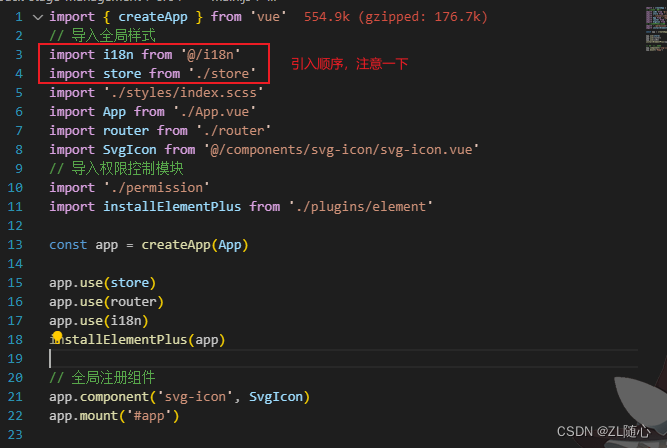
2.2、主题切换
原理
在 scss中,我们可以通过 $变量名:变量值 的方式定义 css 变量,然后通过该 css 变量 来去指定某一块 DOM 对应的颜色,当我改变了该 css 变量 的值,那么所对应的 DOM 颜色也会同步发生变化,当大量的 DOM 都依赖于这个 css 变量 设置颜色时,我们只需要改变这个 css 变量,那么所有 DOM 的颜色都会发生变化,所谓的 主题切换 就可以实现了,这个就是实现 主题切换 的原理。
而在我们的项目中想要实现主题切换,需要同时处理两个方面的内容:
1. element-plus 主题
2. 非 element-plus 主题
那么根据以上关键信息,我们就可以得出对应的实现方案
1. 创建一个组件 ThemeSelect 用来处理修改之后的 css 变量 的值(当然如果是只需要黑白两种主题,也可el-drapdown)
2. 根据新值修改 element-plus 主题色
3. 根据新值修改非 element-plus 主题色
其实主要就是修改样式 element-plus比较复杂
实现步骤:
1. 获取当前 element-plus 的所有样式
2. 定义我们要替换之后的样式
3. 在原样式中,利用正则替换新样式
4. 把替换后的样式写入到 style 标签中
需要用到两个库
rgb-hex:转换RGB(A)颜色为十六进制
css-color-function:在CSS中提出的颜色函数的解析器和转换器
涉及到的文件
utils/theme.js
import color from 'css-color-function'
import rgbHex from 'rgb-hex'
import formula from '@/constant/formula.json'
import axios from 'axios'
import version from 'element-plus/package.json'
/**
* 写入新样式到 style
* @param {*} elNewStyle element-plus 的新样式
* @param {*} isNewStyleTag 是否生成新的 style 标签
*/
export const writeNewStyle = elNewStyle => {
const style = document.createElement('style')
style.innerText = elNewStyle
document.head.appendChild(style)
}
/**
* 根据主色值,生成最新的样式表
*/
export const generateNewStyle = async primaryColor => {
const colors = generateColors(primaryColor)
let cssText = await getOriginalStyle()
// 遍历生成的样式表,在 CSS 的原样式中进行全局替换
Object.keys(colors).forEach(key => {
cssText = cssText.replace(
new RegExp('(:|\\s+)' + key, 'g'),
'$1' + colors[key]
)
})
return cssText
}
/**
* 根据主色生成色值表
*/
export const generateColors = primary => {
if (!primary) return
const colors = {
primary
}
Object.keys(formula).forEach(key => {
const value = formula[key].replace(/primary/g, primary)
colors[key] = '#' + rgbHex(color.convert(value))
})
return colors
}
/**
* 获取当前 element-plus 的默认样式表
*/
const getOriginalStyle = async () => {
const url = `https://unpkg.com/element-plus@${version.version}/dist/index.css`
const { data } = await axios(url)
// 把获取到的数据筛选为原样式模板
return getStyleTemplate(data)
}
/**
* 返回 style 的 template
*/
const getStyleTemplate = data => {
// element-plus 默认色值
const colorMap = {
'#3a8ee6': 'shade-1',
'#409eff': 'primary',
'#53a8ff': 'light-1',
'#66b1ff': 'light-2',
'#79bbff': 'light-3',
'#8cc5ff': 'light-4',
'#a0cfff': 'light-5',
'#b3d8ff': 'light-6',
'#c6e2ff': 'light-7',
'#d9ecff': 'light-8',
'#ecf5ff': 'light-9'
}
// 根据默认色值为要替换的色值打上标记
Object.keys(colorMap).forEach(key => {
const value = colorMap[key]
data = data.replace(new RegExp(key, 'ig'), value)
})
return data
}
store/modules/theme.js
import { getItem, setItem } from '@/utils/storage'
import { MAIN_COLOR, DEFAULT_COLOR } from '@/constant'
import variables from '@/styles/variables.module.scss'
export default {
namespaced: true,
state: () => ({
mainColor: getItem(MAIN_COLOR) || DEFAULT_COLOR,
variables
}),
mutations: {
/**
* 设置主题色
*/
setMainColor(state, newColor) {
state.variables.menuBg = newColor
state.mainColor = newColor
setItem(MAIN_COLOR, newColor)
}
}
}store/getters/index.js

constant/formula.json
{
"shade-1": "color(primary shade(10%))",
"light-1": "color(primary tint(10%))",
"light-2": "color(primary tint(20%))",
"light-3": "color(primary tint(30%))",
"light-4": "color(primary tint(40%))",
"light-5": "color(primary tint(50%))",
"light-6": "color(primary tint(60%))",
"light-7": "color(primary tint(70%))",
"light-8": "color(primary tint(80%))",
"light-9": "color(primary tint(90%))",
"subMenuHover": "color(primary tint(70%))",
"subMenuBg": "color(primary tint(80%))",
"menuHover": "color(primary tint(90%))",
"menuBg": "color(primary)"
}index.js 文件
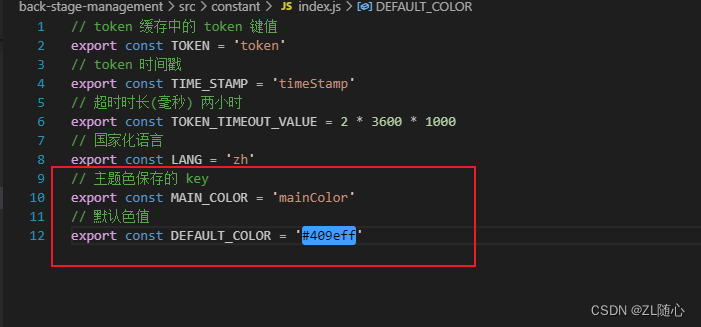
layout.vue文件

SidebarMenu.vue
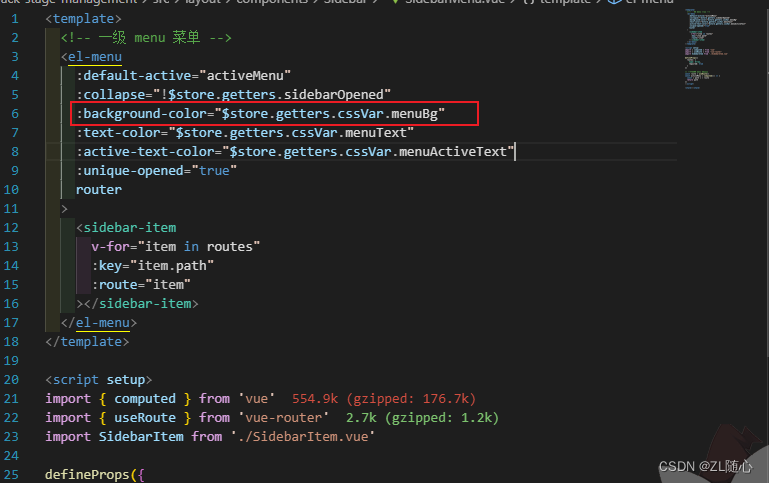
小总结
对于 element-plus:因为 element-plus 是第三方的包,所以它 不是完全可控 的,那么对于这种最简单直白的方案,就是直接拿到它编译后的 css 进行色值替换,利用 style 内部样式表优先级高于 外部样式表 的特性,来进行主题替换
对于自定义主题:因为自定义主题是 完全可控 的,所以我们实现起来就轻松很多,只需要修改对应的 scss 变量即可
2.3、全屏
使用screenfull 库
安装
npm i screenfull封装一个处理全屏的组件,这里图标临时的,具体的需要根据自己项目实际需求来
<template>
<div>
<el-icon @click="onToggle">
<component :is="isFullscreen ? Aim : FullScreen" />
</el-icon>
</div>
</template>
<script setup>
import { FullScreen, Aim } from '@element-plus/icons-vue'
import { ref, onMounted, onUnmounted } from 'vue'
import screenfull from 'screenfull'
// 是否全屏
const isFullscreen = ref(false)
// 监听变化
const change = () => {
isFullscreen.value = screenfull.isFullscreen
}
// 切换事件
const onToggle = () => {
screenfull.toggle()
}
// 设置侦听器
onMounted(() => {
screenfull.on('change', change)
})
// 删除侦听器
onUnmounted(() => {
screenfull.off('change', change)
})
</script>
<style lang="scss" scoped></style>
2.4、头部搜索
整个 headerSearch 其实可以分为三个核心的功能点:
- 根据指定内容对所有页面进行检索
- 以 select 形式展示检索出的页面
- 通过检索页面可快速进入对应页面
方案:对照着三个核心功能点和原理,想要指定对应的实现方案是非常简单的一件事情了
- 创建 headerSearch 组件,用作样式展示和用户输入内容获取
- 获取所有的页面数据,用作被检索的数据源
- 根据用户输入内容在数据源中进行 [模糊搜索](https://fusejs.io/)
- 把搜索到的内容以 select 进行展示
- 监听 select 的 change 事件,完成对应跳转

其主要作用就是快速搜索我们的页面,然后进入页面,效果类似这样
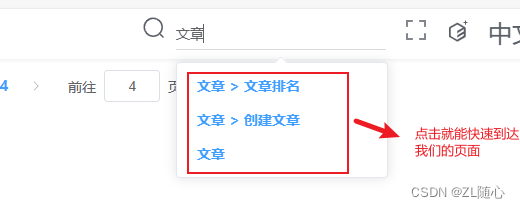
index.vue文件
<template>
<div :class="{ show: isShow }" class="header-search">
<el-icon @click.stop="onShowClick"><Search /></el-icon>
<el-select
ref="headerSearchSelectRef"
class="header-search-select"
v-model="search"
filterable
default-first-option
remote
placeholder="Search"
:remote-method="querySearch"
@change="onSelectChange"
>
<el-option
v-for="option in searchOptions"
:key="option.item.path"
:label="option.item.title.join(' > ')"
:value="option.item"
></el-option>
</el-select>
</div>
</template>
<script setup>
import { ref, computed, watch } from 'vue'
import { useRouter } from 'vue-router'
import { Search } from '@element-plus/icons-vue'
import Fuse from 'fuse.js'
import { watchSwitchLang } from '@/utils/i18n'
import { filterRouters, generateMenus } from '@/utils/route'
import { generateRoutes } from './FuseData'
// 控制 search 显示
const isShow = ref(false)
// el-select 实例
const headerSearchSelectRef = ref(null)
const onShowClick = () => {
isShow.value = !isShow.value
headerSearchSelectRef.value.focus()
}
// search 相关
const search = ref('')
// 搜索结果
const searchOptions = ref([])
// 搜索方法
const querySearch = (query) => {
if (query !== '') {
searchOptions.value = fuse.search(query)
} else {
searchOptions.value = []
}
}
// 选中回调
const onSelectChange = (val) => {
router.push(val.path)
}
// 检索数据源
const router = useRouter()
let searchPool = computed(() => {
const filterRoutes = filterRouters(router.getRoutes())
return generateRoutes(filterRoutes)
})
/**
* 搜索库相关
*/
let fuse
const initFuse = (searchPool) => {
fuse = new Fuse(searchPool, {
// 是否按优先级进行排序
shouldSort: true,
// 匹配长度超过这个值的才会被认为是匹配的
minMatchCharLength: 1,
// 将被搜索的键列表。 这支持嵌套路径、加权搜索、在字符串和对象数组中搜索。
// name:搜索的键
// weight:对应的权重
keys: [
{
name: 'title',
weight: 0.7
},
{
name: 'path',
weight: 0.3
}
]
})
}
initFuse(searchPool.value)
// 处理国际化
watchSwitchLang(() => {
searchPool = computed(() => {
const filterRoutes = filterRouters(router.getRoutes())
return generateRoutes(filterRoutes)
})
initFuse(searchPool.value)
})
/**
* 关闭 search 的处理事件
*/
const onClose = () => {
headerSearchSelectRef.value.blur()
isShow.value = false
searchOptions.value = []
search.value = ''
}
/**
* 监听 search 打开,处理 close 事件
*/
watch(isShow, (val) => {
if (val) {
document.body.addEventListener('click', onClose)
} else {
document.body.removeEventListener('click', onClose)
}
})
</script>
<style lang="scss" scoped>
.header-search {
.search-icon {
cursor: pointer;
font-size: 18px;
vertical-align: middle;
}
.header-search-select {
font-size: 18px;
transition: width 0.2s;
width: 0;
overflow: hidden;
background: transparent;
border-radius: 0;
display: inline-block;
vertical-align: middle;
:deep(.el-select__wrapper) {
border-radius: 0;
border: 0;
padding-left: 0;
padding-right: 0;
box-shadow: none !important;
border-bottom: 1px solid #d9d9d9;
vertical-align: middle;
}
}
&.show {
.header-search-select {
width: 210px;
margin-left: 10px;
}
}
}
</style>
FuseData.js文件
import path from 'path'
import i18n from '@/i18n'
import { resolve } from "@/utils/route.js"
/**
* 筛选出可供搜索的路由对象
* @param routes 路由表
* @param basePath 基础路径,默认为 /
* @param prefixTitle
*/
export const generateRoutes = (routes, basePath = '/', prefixTitle = []) => {
// 创建 result 数据
let res = []
// 循环 routes 路由
for (const route of routes) {
// 创建包含 path 和 title 的 item
const data = {
path: resolve(basePath, route.path),
title: [...prefixTitle]
}
// 当前存在 meta 时,使用 i18n 解析国际化数据,组合成新的 title 内容
// 动态路由不允许被搜索
// 匹配动态路由的正则
const re = /.*\/:.*/
if (route.meta && route.meta.title && !re.exec(route.path)) {
const i18ntitle = i18n.global.t(`msg.route.${route.meta.title}`)
data.title = [...data.title, i18ntitle]
res.push(data)
}
// 存在 children 时,迭代调用
if (route.children) {
const tempRoutes = generateRoutes(route.children, data.path, data.title)
if (tempRoutes.length >= 1) {
res = [...res, ...tempRoutes]
}
}
}
return res
}utils/i18n.js 增加下面的内容
import { watch } from 'vue'
import store from '@/store'
/**
*
* @param {...any} cbs 所有的回调
*/
export function watchSwitchLang(...cbs) {
watch(
() => store.getters.language,
() => {
cbs?.forEach(cb => cb(store.getters.language))
}
)
}2.5、tabViews
实现方案
- 创建 tagsView 组件:用来处理 tags 的展示
- 处理基于路由的动态过渡,在 AppMain 中进行:用于处理 view 的部分
整个的方案就是这么两大部,但是其中我们还需要处理一些细节相关的,**完整的方案为**:
1. 监听路由变化,组成用于渲染 tags 的数据源
2. 创建 tags 组件,根据数据源渲染 tag,渲染出来的 tags 需要同时具备
1. 国际化 title
2. 路由跳转
3. 处理鼠标右键效果,根据右键处理对应数据源
4. 处理基于路由的动态过渡
创建数据源
在contant/index.js 文件下创建
// tags
export const TAGS_VIEW = 'tagsView'在 store/app 中创建 tagsViewList
import { LANG, TAGS_VIEW } from '@/constant'
import { getItem, setItem } from '@/utils/storage'
export default {
namespaced: true,
state: () => ({
...
tagsViewList: getItem(TAGS_VIEW) || []
}),
mutations: {
...
/**
* 添加 tags
*/
addTagsViewList(state, tag) {
const isFind = state.tagsViewList.find(item => {
return item.path === tag.path
})
// 处理重复
if (!isFind) {
state.tagsViewList.push(tag)
setItem(TAGS_VIEW, state.tagsViewList)
}
}
},
actions: {}
}
创建 utils/tags.js
在 appmain 中监听路由的变化
<script setup>
import { watch } from 'vue'
import { isTags } from '@/utils/tags.js'
import { generateTitle } from '@/utils/i18n'
import { useRoute } from 'vue-router'
import { useStore } from 'vuex'
const route = useRoute()
/**
* 生成 title
*/
const getTitle = route => {
let title = ''
if (!route.meta) {
// 处理无 meta 的路由
const pathArr = route.path.split('/')
title = pathArr[pathArr.length - 1]
} else {
title = generateTitle(route.meta.title)
}
return title
}
/**
* 监听路由变化
*/
const store = useStore()
watch(
route,
(to, from) => {
if (!isTags(to.path)) return
const { fullPath, meta, name, params, path, query } = to
store.commit('app/addTagsViewList', {
fullPath,
meta,
name,
params,
path,
query,
title: getTitle(to)
})
},
{
immediate: true
}
)
</script>在 store/ getters/index.js 添加
tagsViewList: state => state.app.tagsViewList在conponents/tagsView 创建 index.vue组件
<template>
<div class="tags-view-container">
<el-scrollbar class="tags-view-wrapper">
<router-link
class="tags-view-item"
:class="isActive(tag) ? 'active' : ''"
:style="{
backgroundColor: isActive(tag) ? $store.getters.cssVar.menuBg : '',
borderColor: isActive(tag) ? $store.getters.cssVar.menuBg : ''
}"
v-for="(tag, index) in $store.getters.tagsViewList"
:key="tag.fullPath"
:to="{ path: tag.fullPath }"
@contextmenu.prevent="openMenu($event, index)"
>
{{ tag.title }}
<el-icon
v-show="!isActive(tag)"
@click.prevent.stop="onCloseClick(index)"
>
<Close />
</el-icon>
</router-link>
</el-scrollbar>
<context-menu
v-show="visible"
:style="menuStyle"
:index="selectIndex"
></context-menu>
</div>
</template>
<script setup>
import { ref, reactive, watch } from 'vue'
import { useRoute } from 'vue-router'
import { Close } from '@element-plus/icons-vue'
import ContextMenu from './ContextMenu.vue'
import { useStore } from 'vuex'
const route = useRoute()
/**
* 是否被选中
*/
const isActive = (tag) => {
console.log('tag.path === route.path', tag.path === route.path)
return tag.path === route.path
}
// contextMenu 相关
const selectIndex = ref(0)
const visible = ref(false)
const menuStyle = reactive({
left: 0,
top: 0
})
/**
* 展示 menu
*/
const openMenu = (e, index) => {
const { x, y } = e
menuStyle.left = x + 'px'
menuStyle.top = y + 'px'
selectIndex.value = index
visible.value = true
}
/**
* 关闭 menu
*/
const closeMenu = () => {
visible.value = false
}
/**
* 监听变化
*/
watch(visible, (val) => {
if (val) {
document.body.addEventListener('click', closeMenu)
} else {
document.body.removeEventListener('click', closeMenu)
}
})
/**
* 关闭 tag 的点击事件
*/
const store = useStore()
const onCloseClick = (index) => {
store.commit('app/removeTagsView', {
type: 'index',
index: index
})
}
</script>
<style lang="scss" scoped>
.tags-view-container {
height: 34px;
width: 100%;
background: #fff;
border-bottom: 1px solid #d8dce5;
box-shadow:
0 1px 3px 0 rgba(0, 0, 0, 0.12),
0 0 3px 0 rgba(0, 0, 0, 0.04);
.tags-view-item {
display: inline-block;
position: relative;
cursor: pointer;
height: 26px;
line-height: 26px;
border: 1px solid #d8dce5;
color: #495060;
background: #fff;
padding: 0 8px;
font-size: 12px;
margin-left: 5px;
margin-top: 4px;
&:first-of-type {
margin-left: 15px;
}
&:last-of-type {
margin-right: 15px;
}
&.active {
color: #fff;
&::before {
content: '';
background: #fff;
display: inline-block;
width: 8px;
height: 8px;
border-radius: 50%;
position: relative;
margin-right: 4px;
}
}
// close 按钮
.el-icon-close {
width: 16px;
height: 16px;
line-height: 10px;
vertical-align: 2px;
border-radius: 50%;
text-align: center;
transition: all 0.3s cubic-bezier(0.645, 0.045, 0.355, 1);
transform-origin: 100% 50%;
&:before {
transform: scale(0.6);
display: inline-block;
vertical-align: -3px;
}
&:hover {
background-color: #b4bccc;
color: #fff;
}
}
}
}
</style>
在layout/layout.vue 中引入
<div class="fixed-header">
<!-- 顶部的 navbar -->
<navbar />
<!-- tags -->
<tags-view></tags-view>
</div>
import TagsView from '@/components/TagsView.index.vue'tagsView 的国际化处理可以理解为修改现有 tags 的 title
1. 监听到语言变化
2. 国际化对应的 title 即可
在 store/app 中,创建修改 ttile 的 mutations
/**
* 为指定的 tag 修改 title
*/
changeTagsView(state, { index, tag }) {
state.tagsViewList[index] = tag
setItem(TAGS_VIEW, state.tagsViewList)
}在 AppMain.vue
<template>
<div class="app-main">
<div class="app-main">
<router-view v-slot="{ Component, route }">
<transition name="fade-transform" mode="out-in">
<keep-alive>
<component :is="Component" :key="route.path" />
</keep-alive>
</transition>
</router-view>
</div>
</div>
</template>
<script setup>
import { watch } from 'vue'
import { useRoute } from 'vue-router'
import { useStore } from 'vuex'
import { isTags } from '@/utils/tags.js'
import { generateTitle, watchSwitchLang } from '@/utils/i18n'
const route = useRoute()
/**
* 生成 title
*/
const getTitle = (route) => {
let title = ''
if (!route.meta) {
// 处理无 meta 的路由
const pathArr = route.path.split('/')
title = pathArr[pathArr.length - 1]
} else {
title = generateTitle(route.meta.title)
}
return title
}
/**
* 监听路由变化
*/
const store = useStore()
watch(
route,
(to, from) => {
if (!isTags(to.path)) return
const { fullPath, meta, name, params, path, query } = to
store.commit('app/addTagsViewList', {
fullPath,
meta,
name,
params,
path,
query,
title: getTitle(to)
})
},
{
immediate: true
}
)
/**
* 国际化 tags
*/
watchSwitchLang(() => {
store.getters.tagsViewList.forEach((route, index) => {
store.commit('app/changeTagsView', {
index,
tag: {
...route,
title: getTitle(route)
}
})
})
})
</script>
<style lang="scss" scoped>
.app-main {
min-height: calc(100vh - 50px - 43px);
width: 100%;
padding: 104px 20px 20px 20px;
position: relative;
overflow: hidden;
padding: 61px 20px 20px 20px;
box-sizing: border-box;
}
</style>
contextMenu 为 鼠标右键事件
- contextMenu 的展示
- 右键项对应逻辑处理
创建 components/TagsView/ContextMenu.vue组件 组件,作为右键展示部分
<template>
<ul class="context-menu-container">
<li @click="onRefreshClick">
{{ $t('msg.tagsView.refresh') }}
</li>
<li @click="onCloseRightClick">
{{ $t('msg.tagsView.closeRight') }}
</li>
<li @click="onCloseOtherClick">
{{ $t('msg.tagsView.closeOther') }}
</li>
</ul>
</template>
<script setup>
import { defineProps } from 'vue'
import { useRouter } from 'vue-router'
import { useStore } from 'vuex'
const props = defineProps({
index: {
type: Number,
required: true
}
})
const router = useRouter()
const onRefreshClick = () => {
router.go(0)
}
const store = useStore()
const onCloseRightClick = () => {
store.commit('app/removeTagsView', {
type: 'right',
index: props.index
})
}
const onCloseOtherClick = () => {
store.commit('app/removeTagsView', {
type: 'other',
index: props.index
})
}
</script>
<style lang="scss" scoped>
.context-menu-container {
position: fixed;
background: #fff;
z-index: 3000;
list-style-type: none;
padding: 5px 0;
border-radius: 4px;
font-size: 12px;
font-weight: 400;
color: #333;
box-shadow: 2px 2px 3px 0 rgba(0, 0, 0, 0.3);
li {
margin: 0;
padding: 7px 16px;
cursor: pointer;
&:hover {
background: #eee;
}
}
}
</style>
在styles/transition.scss 增加下面样式
/* fade-transform */
.fade-transform-leave-active,
.fade-transform-enter-active {
transition: all 0.5s;
}
.fade-transform-enter-from {
opacity: 0;
transform: translateX(-30px);
}
.fade-transform-leave-to {
opacity: 0;
transform: translateX(30px);
}2.6、Guide 引导
guide 指的就是 引导页
流程
- 高亮某一块指定的样式
- 在高亮的样式处通过文本展示内容
- 用户可以进行下一次高亮或者关闭事件
安装 driver.js
npm i driver.jscomponents/Guide.vue 组件
<template>
<div>
<el-tooltip :content="$t('msg.navBar.guide')">
<el-icon id="guide-start"><Guide /></el-icon>
</el-tooltip>
</div>
</template>
<script setup>
import { onMounted } from 'vue'
import { useI18n } from 'vue-i18n'
import { driver } from 'driver.js'
import 'driver.js/dist/driver.css'
import { Guide } from '@element-plus/icons-vue'
import steps from './steps'
const i18n = useI18n()
onMounted(() => {
const driverObj = driver({
showProgress: true,
steps: steps(i18n)
})
driverObj.drive()
})
</script>
<style scoped></style>
在navbar 中导入该组件
<guide class="right-menu-item hover-effect" />
import Guide from '@/components/Guide/index.vue'steps.js 文件里面
const steps = i18n => {
return [
{
element: '#guide-start',
popover: {
title: i18n.t('msg.guide.guideTitle'),
description: i18n.t('msg.guide.guideDesc'),
position: 'bottom-right'
}
},
{
element: '#guide-hamburger',
popover: {
title: i18n.t('msg.guide.hamburgerTitle'),
description: i18n.t('msg.guide.hamburgerDesc')
}
},
{
element: '#guide-breadcrumb',
popover: {
title: i18n.t('msg.guide.breadcrumbTitle'),
description: i18n.t('msg.guide.breadcrumbDesc')
}
},
{
element: '#guide-search',
popover: {
title: i18n.t('msg.guide.searchTitle'),
description: i18n.t('msg.guide.searchDesc'),
position: 'bottom-right'
}
},
{
element: '#guide-full',
popover: {
title: i18n.t('msg.guide.fullTitle'),
description: i18n.t('msg.guide.fullDesc'),
position: 'bottom-right'
}
},
{
element: '#guide-theme',
popover: {
title: i18n.t('msg.guide.themeTitle'),
description: i18n.t('msg.guide.themeDesc'),
position: 'bottom-right'
}
},
{
element: '#guide-lang',
popover: {
title: i18n.t('msg.guide.langTitle'),
description: i18n.t('msg.guide.langDesc'),
position: 'bottom-right'
}
},
{
element: '#guide-tags',
popover: {
title: i18n.t('msg.guide.tagTitle'),
description: i18n.t('msg.guide.tagDesc')
}
},
{
element: '#guide-sidebar',
popover: {
title: i18n.t('msg.guide.sidebarTitle'),
description: i18n.t('msg.guide.sidebarDesc'),
position: 'right-center'
}
}
]
}
export default steps最后一步就是找到你需要在那个元素展示这些指引了,就将上面element 对应的id绑定到对应的元素,例如

其他元素也是如此即可
3、个人中心模块
根据功能划分,整个项目应该包含 4 个组件,分别对应着 4 个功能。
所以,我们想要完成 个人中心模块基本布局 那么就需要先创建出这四个组件
1. 在 views/profile/components 下创建 项目介绍 组件 ProjectCard
2. 在 views/profile/components 下创建 功能 组件 feature
3. 在 views/profile/components 下创建 章节 组件 chapter
4. 在 views/profile/components 下创建 作者 组件 author
5. 进入到 views/profile/index.vue 页面,绘制基本布局结构
效果
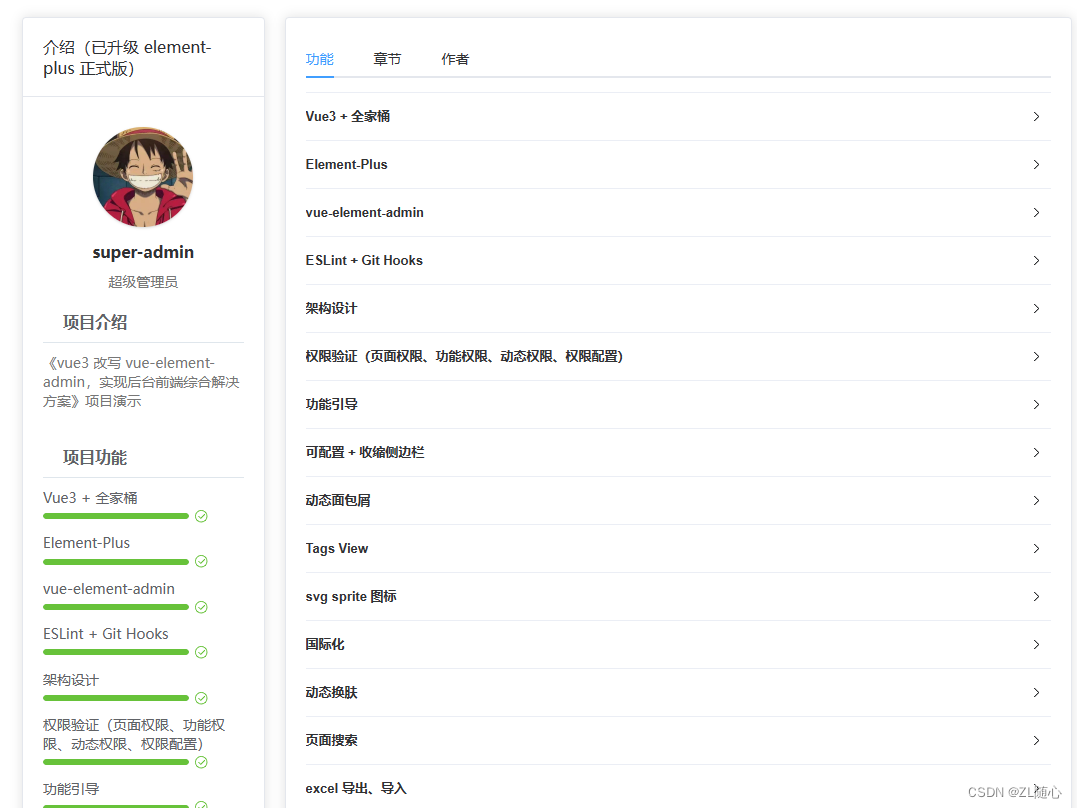
3.1、入口组件、即index.vue组件
<template>
<div class="my-container">
<el-row>
<el-col :span="6">
<project-card class="user-card" :features="featureData"></project-card>
</el-col>
<el-col :span="18">
<el-card>
<el-tabs v-model="activeName">
<el-tab-pane :label="$t('msg.profile.feature')" name="feature">
<feature :features="featureData" />
</el-tab-pane>
<el-tab-pane :label="$t('msg.profile.chapter')" name="chapter">
<chapter />
</el-tab-pane>
<el-tab-pane :label="$t('msg.profile.author')" name="author">
<author />
</el-tab-pane>
</el-tabs>
</el-card>
</el-col>
</el-row>
</div>
</template>
<script setup>
import ProjectCard from './components/ProjectCard.vue'
import Chapter from './components/Chapter.vue'
// eslint-disable-next-line
import Feature from './components/Feature.vue'
import Author from './components/Author.vue'
import { ref } from 'vue'
import { feature } from '@/api/user'
import { watchSwitchLang } from '@/utils/i18n'
const activeName = ref('feature')
const featureData = ref([])
const getFeatureData = async () => {
featureData.value = await feature()
}
getFeatureData()
// 监听语言切换
watchSwitchLang(getFeatureData)
</script>
<style lang="scss" scoped>
.my-container {
.user-card {
margin-right: 20px;
}
}
</style>
3.2、ProjectCard 组件
<template>
<el-card class="user-container">
<template #header>
<div class="header">
<span>{{ $t('msg.profile.introduce') }}</span>
</div>
</template>
<div class="user-profile">
<!-- 头像 -->
<div class="box-center">
<pan-thumb
:image="$store.getters.userInfo.avatar"
:height="'100px'"
:width="'100px'"
:hoverable="false"
>
<div>Hello</div>
{{ $store.getters.userInfo.title }}
</pan-thumb>
</div>
<!-- 姓名 && 角色 -->
<div class="box-center">
<div class="user-name text-center">
{{ $store.getters.userInfo.username }}
</div>
<div class="user-role text-center text-muted">
{{ $store.getters.userInfo.title }}
</div>
</div>
</div>
<!-- 简介 -->
<div class="project-bio">
<div class="project-bio-section">
<div class="project-bio-section-header">
<el-icon><Document /></el-icon>
<span>{{ $t('msg.profile.projectIntroduction') }}</span>
</div>
<div class="project-bio-section-body">
<div class="text-muted">
{{ $t('msg.profile.muted') }}
</div>
</div>
</div>
<div class="project-bio-section">
<div class="project-bio-section-header">
<el-icon><Calendar /></el-icon>
<span>{{ $t('msg.profile.projectFunction') }} </span>
</div>
<div class="project-bio-section-body">
<div class="progress-item" v-for="item in features" :key="item.id">
<div>{{ item.title }}</div>
<el-progress :percentage="item.percentage" status="success" />
</div>
</div>
</div>
</div>
</el-card>
</template>
<script setup>
import { Document, Calendar } from '@element-plus/icons-vue'
import PanThumb from './PanThumb.vue'
defineProps({
features: {
type: Array,
required: true
}
})
</script>
<style lang="scss" scoped>
.user-container {
.text-muted {
font-size: 14px;
color: #777;
}
.user-profile {
text-align: center;
.user-name {
font-weight: bold;
}
.box-center {
padding-top: 10px;
}
.user-role {
padding-top: 10px;
font-weight: 400;
}
}
.project-bio {
margin-top: 20px;
color: #606266;
span {
padding-left: 4px;
}
.project-bio-section {
margin-bottom: 36px;
.project-bio-section-header {
border-bottom: 1px solid #dfe6ec;
padding-bottom: 10px;
margin-bottom: 10px;
font-weight: bold;
}
.project-bio-section-body {
.progress-item {
margin-top: 10px;
div {
font-size: 14px;
margin-bottom: 2px;
}
}
}
}
}
}
</style>
3.3、feature 组件
<template>
<el-collapse v-model="activeName" accordion>
<el-collapse-item
v-for="item in features"
:key="item.id"
:title="item.title"
:name="item.id"
>
<div v-html="item.content"></div>
</el-collapse-item>
</el-collapse>
</template>
<script setup>
import { ref } from 'vue'
const activeName = ref(0)
defineProps({
features: {
type: Array,
required: true
}
})
</script>
<style lang="scss" scoped>
::v-deep .el-collapse-item__header {
font-weight: bold;
}
.el-collapse-item {
:deep(a) {
color: #2d62f7;
margin: 0 4px;
}
}
</style>
3.4、chapter组件
<template>
<el-timeline>
<el-timeline-item
v-for="item in chapterData"
:key="item.id"
:timestamp="item.timestamp"
placement="top"
>
<el-card>
<h4>{{ item.content }}</h4>
</el-card>
</el-timeline-item>
</el-timeline>
</template>
<script setup>
import { watchSwitchLang } from '@/utils/i18n'
import { chapter } from '@/api/user'
import { ref } from 'vue'
const chapterData = ref([])
const getChapterData = async () => {
chapterData.value = await chapter()
}
getChapterData()
// 监听语言切换
watchSwitchLang(getChapterData)
</script>
<style lang="scss" scoped></style>
3.5、author 组件
<template>
<div class="author-container">
<div class="header">
<pan-thumb
image="https://img4.sycdn.imooc.com/61110c2b0001152907400741-140-140.jpg"
height="60px"
width="60px"
:hoverable="false"
>
{{ $t('msg.profile.name') }}
</pan-thumb>
<div class="header-desc">
<h3>{{ $t('msg.profile.name') }}</h3>
<span>{{ $t('msg.profile.job') }}</span>
</div>
</div>
<div class="info">
{{ $t('msg.profile.Introduction') }}
</div>
</div>
</template>
<script setup>
import PanThumb from './PanThumb.vue'
</script>
<style lang="scss" scoped>
.author-container {
.header {
display: flex;
.header-desc {
margin-left: 12px;
display: flex;
flex-direction: column;
justify-content: space-around;
span {
font-size: 14px;
}
}
}
.info {
margin-top: 16px;
line-height: 22px;
font-size: 14px;
text-indent: 26px;
}
}
</style>
3.6、PanThumb 组件
<template>
<div
:style="{ zIndex: zIndex, height: height, width: width }"
class="pan-item"
>
<div class="pan-info">
<div class="pan-info-roles-container">
<slot />
</div>
</div>
<div :style="{ backgroundImage: `url(${image})` }" class="pan-thumb"></div>
</div>
</template>
<script setup>
defineProps({
image: {
type: String
},
zIndex: {
type: Number,
default: 1
},
width: {
type: String,
default: '150px'
},
height: {
type: String,
default: '150px'
}
})
</script>
<style scoped>
.pan-item {
width: 200px;
height: 200px;
border-radius: 50%;
display: inline-block;
position: relative;
cursor: pointer;
box-shadow: 0 1px 3px rgba(0, 0, 0, 0.2);
.pan-info {
position: absolute;
width: inherit;
height: inherit;
border-radius: 50%;
overflow: hidden;
box-shadow: inset 0 0 0 5px rgba(0, 0, 0, 0.05);
h3 {
color: #fff;
text-transform: uppercase;
position: relative;
letter-spacing: 2px;
font-size: 14px;
margin: 0 60px;
padding: 22px 0 0 0;
height: 85px;
font-family: 'Open Sans', Arial, sans-serif;
text-shadow:
0 0 1px #fff,
0 1px 2px rgba(0, 0, 0, 0.3);
}
p {
color: #fff;
padding: 10px 5px;
font-style: italic;
margin: 0 30px;
font-size: 12px;
border-top: 1px solid rgba(255, 255, 255, 0.5);
a {
display: block;
color: #333;
width: 80px;
height: 80px;
background: rgba(255, 255, 255, 0.3);
border-radius: 50%;
color: #fff;
font-style: normal;
font-weight: 700;
text-transform: uppercase;
font-size: 9px;
letter-spacing: 1px;
padding-top: 24px;
margin: 7px auto 0;
font-family: 'Open Sans', Arial, sans-serif;
opacity: 0;
transition:
transform 0.3s ease-in-out 0.2s,
opacity 0.3s ease-in-out 0.2s,
background 0.2s linear 0s;
transform: translateX(60px) rotate(90deg);
}
a:hover {
background: rgba(255, 255, 255, 0.5);
}
}
.pan-info-roles-container {
padding: 20px;
text-align: center;
}
}
.pan-thumb {
width: 100%;
height: 100%;
background-position: center center;
background-size: cover;
border-radius: 50%;
overflow: hidden;
position: absolute;
transform-origin: 95% 40%;
transition: all 0.3s ease-in-out;
}
.pan-item:hover .pan-thumb {
transform: rotate(-110deg);
}
.pan-item:hover .pan-info p a {
opacity: 1;
transform: translateX(0px) rotate(0deg);
}
}
</style>
api/user.js文件
import request from '@/utils/request'
export const feature = () => {
return request({
url: '/user/feature'
})
}
export const chapter = () => {
return request({
url: '/user/chapter'
})
}
4、用户模块
4.1、用户列表
在src下创建 filters/index.js
import dayjs from 'dayjs'
const dateFilter = (val, format = 'YYYY-MM-DD') => {
if (!isNaN(val)) {
val = parseInt(val)
}
return dayjs(val).format(format)
}
export default app => {
app.config.globalProperties.$filters = {
dateFilter
}
}安装 dayjs
npm i dayjs在main.js 中引入
// filter
import installFilter from '@/filters'
installFilter(app)这样子就可以,格式化时间列了
<el-table-column :label="$t('msg.excel.openTime')">
<template #default="{ row }">
{{ $filters.dateFilter(row.openTime) }}
</template>
</el-table-column>4.2、excel导入解决方案
其实对于这种导入的情况,我们一般是,导入文件,让后端去解释,然后导入成功之后,再请求一个接口,将导入的数据请求回来,并展示的,当然,也可以像这里这样导入后前端解释,再将数据存到后端,就相当于是批新建了。
方案:
搭建一个上传文件的组件,这里命名为 UploadExcel.vue
<template>
<div class="upload-excel">
<div class="btn-upload">
<el-button :loading="loading" type="primary" @click="handleUpload">
{{ $t('msg.uploadExcel.upload') }}
</el-button>
</div>
<input
ref="excelUploadInput"
class="excel-upload-input"
type="file"
accept=".xlsx, .xls"
@change="handleChange"
/>
<!-- https://developer.mozilla.org/zh-CN/docs/Web/API/HTML_Drag_and_Drop_API -->
<div
class="drop"
@drop.stop.prevent="handleDrop"
@dragover.stop.prevent="handleDragover"
@dragenter.stop.prevent="handleDragover"
>
<el-icon><UploadFilled /></el-icon>
<span>{{ $t('msg.uploadExcel.drop') }}</span>
</div>
</div>
</template>
<script setup>
import { ElMessage } from 'element-plus'
import { UploadFilled } from '@element-plus/icons-vue'
import * as XLSX from 'xlsx'
import { ref } from 'vue'
import { getHeaderRow, isExcel } from './utils'
const props = defineProps({
// 上传前回调
beforeUpload: Function,
// 成功回调
onSuccess: Function
})
/**
* 点击上传触发
*/
const loading = ref(false)
const excelUploadInput = ref(null)
const handleUpload = () => {
excelUploadInput.value.click()
}
const handleChange = (e) => {
const files = e.target.files
const rawFile = files[0] // only use files[0]
if (!rawFile) return
upload(rawFile)
}
/**
* 触发上传事件
*/
const upload = (rawFile) => {
excelUploadInput.value.value = null
// 如果没有指定上传前回调的话
if (!props.beforeUpload) {
readerData(rawFile)
return
}
// 如果指定了上传前回调,那么只有返回 true 才会执行后续操作
const before = props.beforeUpload(rawFile)
if (before) {
readerData(rawFile)
}
}
/**
* 读取数据(异步)
*/
const readerData = (rawFile) => {
loading.value = true
return new Promise((resolve, reject) => {
// https://developer.mozilla.org/zh-CN/docs/Web/API/FileReader
const reader = new FileReader()
// 该事件在读取操作完成时触发
// https://developer.mozilla.org/zh-CN/docs/Web/API/FileReader/onload
reader.onload = (e) => {
// 1. 获取解析到的数据
const data = e.target.result
// 2. 利用 XLSX 对数据进行解析
const workbook = XLSX.read(data, { type: 'array' })
// 3. 获取第一张表格(工作簿)名称
const firstSheetName = workbook.SheetNames[0]
// 4. 只读取 Sheet1(第一张表格)的数据
const worksheet = workbook.Sheets[firstSheetName]
// 5. 解析数据表头
const header = getHeaderRow(worksheet)
// 6. 解析数据体
const results = XLSX.utils.sheet_to_json(worksheet)
// 7. 传入解析之后的数据
generateData({ header, results })
// 8. loading 处理
loading.value = false
// 9. 异步完成
resolve()
}
// 启动读取指定的 Blob 或 File 内容
reader.readAsArrayBuffer(rawFile)
})
}
/**
* 根据导入内容,生成数据
*/
const generateData = (excelData) => {
props.onSuccess && props.onSuccess(excelData)
}
/**
* 拖拽文本释放时触发
*/
const handleDrop = (e) => {
// 上传中跳过
if (loading.value) return
const files = e.dataTransfer.files
if (files.length !== 1) {
ElMessage.error('必须要有一个文件')
return
}
const rawFile = files[0]
if (!isExcel(rawFile)) {
ElMessage.error('文件必须是 .xlsx, .xls, .csv 格式')
return false
}
// 触发上传事件
upload(rawFile)
}
/**
* 拖拽悬停时触发
*/
const handleDragover = (e) => {
// https://developer.mozilla.org/zh-CN/docs/Web/API/DataTransfer/dropEffect
// 在新位置生成源项的副本
e.dataTransfer.dropEffect = 'copy'
}
</script>
<style lang="scss" scoped>
.upload-excel {
display: flex;
justify-content: center;
margin-top: 100px;
.excel-upload-input {
display: none;
z-index: -9999;
}
.btn-upload,
.drop {
border: 1px dashed #bbb;
width: 350px;
height: 160px;
text-align: center;
line-height: 160px;
}
.drop {
line-height: 60px;
display: flex;
flex-direction: column;
justify-content: center;
color: #bbb;
display: flex;
flex-direction: column;
justify-content: center;
align-items: center;
cursor: pointer;
i {
font-size: 60px;
display: block;
}
}
}
</style>
utils.js 文件
import * as XLSX from 'xlsx'
/**
* 获取表头(通用方式)
*/
export const getHeaderRow = sheet => {
const headers = []
const range = XLSX.utils.decode_range(sheet['!ref'])
let C
const R = range.s.r
/* start in the first row */
for (C = range.s.c; C <= range.e.c; ++C) {
/* walk every column in the range */
const cell = sheet[XLSX.utils.encode_cell({ c: C, r: R })]
/* find the cell in the first row */
let hdr = 'UNKNOWN ' + C // <-- replace with your desired default
if (cell && cell.t) hdr = XLSX.utils.format_cell(cell)
headers.push(hdr)
}
return headers
}
export const isExcel = file => {
return /\.(xlsx|xls|csv)$/.test(file.name)
}
这里有个小知识点,就使用 Keep-Alive 缓存的组件涉及到两个钩子 onActivated:组件激活时的钩子、onDeactivated:组件不激活时的钩子
4.3、Excel导出方案
需要安装两个库
npm i xlsx
npm i file-saver
主要就是两块
1、主逻辑
const onConfirm = async () => {
loading.value = true
const allUser = (await getUserManageAllList()).list
// 将一个对象转成数组 例如 {a:"xxx", b:"yyyy"} => ["xxx","yyyy"]
const data = formatJson(USER_RELATIONS, allUser)
// 导入工具包(这里面就是处理json数据向excel文件转换的主要方法)
const excel = await import('@/utils/Export2Excel.js')
excel.export_json_to_excel({
// excel 表头
header: Object.keys(USER_RELATIONS),
// excel 数据(二维数组结构)
data,
// 文件名称
filename: excelName.value || exportDefaultName,
// 是否自动列宽
autoWidth: true,
// 文件类型
bookType: 'xlsx'
})
closed()
}2、将列表数据转成excel 类型数据
// 该方法负责将数组转化成二维数组
const formatJson = (headers, rows) => {
// 首先遍历数组
// [{ username: '张三'},{},{}] => [[’张三'],[],[]]
return rows.map((item) => {
return Object.keys(headers).map((key) => {
// 角色特殊处理
if (headers[key] === 'role') {
const roles = item[headers[key]]
return JSON.stringify(roles.map((role) => role.title))
}
return item[headers[key]]
})
})
}2、调用网上成熟的处理 excel 的解决方案 (Export2Excel.js文件)
/* eslint-disable */
import { saveAs } from 'file-saver'
import * as XLSX from 'xlsx'
function datenum(v, date1904) {
if (date1904) v += 1462
var epoch = Date.parse(v)
return (epoch - new Date(Date.UTC(1899, 11, 30))) / (24 * 60 * 60 * 1000)
}
function sheet_from_array_of_arrays(data, opts) {
var ws = {}
var range = {
s: {
c: 10000000,
r: 10000000
},
e: {
c: 0,
r: 0
}
}
for (var R = 0; R != data.length; ++R) {
for (var C = 0; C != data[R].length; ++C) {
if (range.s.r > R) range.s.r = R
if (range.s.c > C) range.s.c = C
if (range.e.r < R) range.e.r = R
if (range.e.c < C) range.e.c = C
var cell = {
v: data[R][C]
}
if (cell.v == null) continue
var cell_ref = XLSX.utils.encode_cell({
c: C,
r: R
})
if (typeof cell.v === 'number') cell.t = 'n'
else if (typeof cell.v === 'boolean') cell.t = 'b'
else if (cell.v instanceof Date) {
cell.t = 'n'
cell.z = XLSX.SSF._table[14]
cell.v = datenum(cell.v)
} else cell.t = 's'
ws[cell_ref] = cell
}
}
if (range.s.c < 10000000) ws['!ref'] = XLSX.utils.encode_range(range)
return ws
}
function Workbook() {
if (!(this instanceof Workbook)) return new Workbook()
this.SheetNames = []
this.Sheets = {}
}
function s2ab(s) {
var buf = new ArrayBuffer(s.length)
var view = new Uint8Array(buf)
for (var i = 0; i != s.length; ++i) view[i] = s.charCodeAt(i) & 0xff
return buf
}
export const export_json_to_excel = ({
multiHeader = [],
header,
data,
filename,
merges = [],
autoWidth = true,
bookType = 'xlsx'
} = {}) => {
// 1. 设置文件名称
filename = filename || 'excel-list'
// 2. 把数据解析为数组,并把表头添加到数组的头部
data = [...data]
data.unshift(header)
// 3. 解析多表头,把多表头的数据添加到数组头部(二维数组)
for (let i = multiHeader.length - 1; i > -1; i--) {
data.unshift(multiHeader[i])
}
// 4. 设置 Excel 表工作簿(第一张表格)名称
var ws_name = 'SheetJS'
// 5. 生成工作簿对象
var wb = new Workbook()
// 6. 将 data 数组(json格式)转化为 Excel 数据格式
var ws = sheet_from_array_of_arrays(data)
// 7. 合并单元格相关(['A1:A2', 'B1:D1', 'E1:E2'])
if (merges.length > 0) {
if (!ws['!merges']) ws['!merges'] = []
merges.forEach((item) => {
ws['!merges'].push(XLSX.utils.decode_range(item))
})
}
// 8. 单元格宽度相关
if (autoWidth) {
/*设置 worksheet 每列的最大宽度*/
const colWidth = data.map((row) =>
row.map((val) => {
/*先判断是否为null/undefined*/
if (val == null) {
return {
wch: 10
}
} else if (val.toString().charCodeAt(0) > 255) {
/*再判断是否为中文*/
return {
wch: val.toString().length * 2
}
} else {
return {
wch: val.toString().length
}
}
})
)
/*以第一行为初始值*/
let result = colWidth[0]
for (let i = 1; i < colWidth.length; i++) {
for (let j = 0; j < colWidth[i].length; j++) {
if (result[j]['wch'] < colWidth[i][j]['wch']) {
result[j]['wch'] = colWidth[i][j]['wch']
}
}
}
ws['!cols'] = result
}
// 9. 添加工作表(解析后的 excel 数据)到工作簿
wb.SheetNames.push(ws_name)
wb.Sheets[ws_name] = ws
// 10. 写入数据
var wbout = XLSX.write(wb, {
bookType: bookType,
bookSST: false,
type: 'binary'
})
// 11. 下载数据
saveAs(
new Blob([s2ab(wbout)], {
type: 'application/octet-stream'
}),
`${filename}.${bookType}`
)
}
4.4、打印
安装
npm i vue3-print-nb新建 directives/index.js
import print from 'vue3-print-nb'
export default app => {
app.use(print)
}在main.js中引入使用
import installDirective from '@/directives'
installDirective(app)在使用的地方就直接使用指令的方式使用了
// 打印按钮
<el-button type="primary" v-print="printObj" :loading="printLoading">
{{ $t('msg.userInfo.print') }}
</el-button>
// 一个配置对象
const printObj = {
// 打印区域,打印这个元素下里面的内容
id: 'userInfoBox',
// 打印标题
popTitle: 'test-vue-element-admin',
// 打印前
beforeOpenCallback(vue) {
printLoading.value = true
},
// 执行打印
openCallback(vue) {
printLoading.value = false
}
}小知识点
路由配置像下面这样配置

则在user-info组件内就可以像组件传参一样接受参数了

5、权限控制解决方案与角色、权限
5.1、页面权限 ,也就是动态路由的处理
1、页面权限实现的核心在于 路由表配置
请求用户信息的时候,有这样的信息

那我们配置路由表可以像下面这样配置
分别创建对应页面模块,例如 UserManage.js
import layout from '@/layout/layout.vue'
export default {
path: '/user',
component: layout,
redirect: '/user/manage',
// 这个name 要与 权限信息对应上
name: 'userManage',
meta: {
title: 'user',
icon: 'personnel'
},
children: [
{
path: '/user/manage',
component: () => import('@/views/user-manage/index.vue'),
meta: {
title: 'userManage',
icon: 'personnel-manage'
}
},
{
path: '/user/info/:id',
name: 'userInfo',
component: () => import('@/views/user-info/index.vue'),
props: true,
meta: {
title: 'userInfo'
}
},
{
path: '/user/import',
name: 'import',
component: () => import('@/views/import/index.vue'),
meta: {
title: 'excelImport'
}
}
]
}
RoleList.js
import layout from '@/layout/layout.vue'
export default {
path: '/user',
component: layout,
redirect: '/user/manage',
name: 'roleList',
meta: {
title: 'user',
icon: 'personnel'
},
children: [
{
path: '/user/role',
component: () => import('@/views/role-list/index.vue'),
meta: {
title: 'roleList',
icon: 'role'
}
}
]
}不一一列举,他们对应的页面展示是这样的,layout.vue就是最外层布局组件了

对应的私有路由表

2、路由表配置的核心在于根据获取到的用户权限从私有路由表 privateRoutes 过滤出当前用户拥有的页面路由
privateRoutes 数据是这样的,这样就可以和我们上面权限信息,menus匹配上了
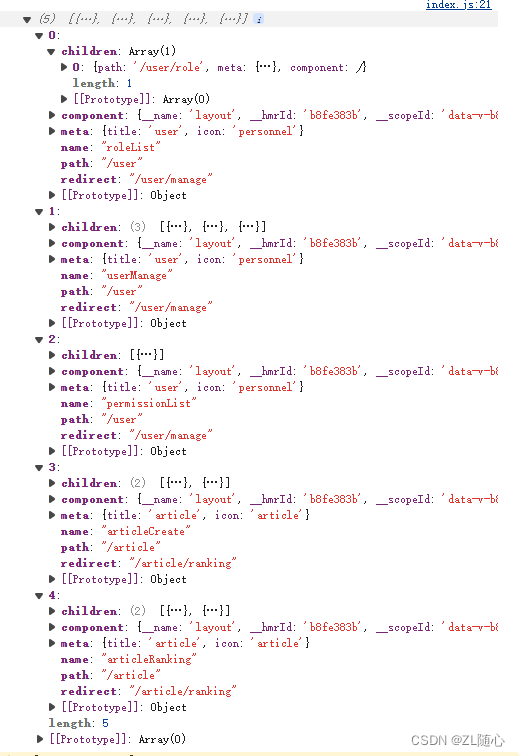
然后就可以通过下面这方法过滤出,用户所拥有的权限了
/**
* 根据权限筛选路由
* menus 请求接口返回的 拥有的权限信息(与我们的路由名字匹配)
* 例如是 ['userManage', 'import'...]
*/
filterRoutes(context, menus) {
const routes = []
// 路由权限匹配
menus.forEach(key => {
// 权限名 与 路由的 name 匹配
routes.push(...privateRoutes.filter(item => item.name === key))
})
// 最后添加 不匹配路由进入 404
routes.push({
path: '/:catchAll(.*)',
redirect: '/404'
})
context.commit('setRoutes', routes)
return routes
}3、然后根据过滤出来的路由,遍历调用 addRoute 方法将路由添加进路由表中
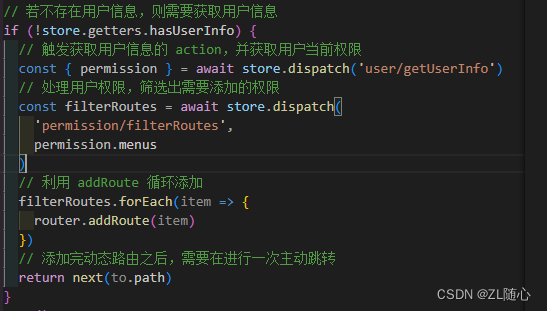
4、添加完路由后需要手动跳转一次路由,也就是上面 return next(to.path)
5.2、功能权限、一般是控制按钮显示与否
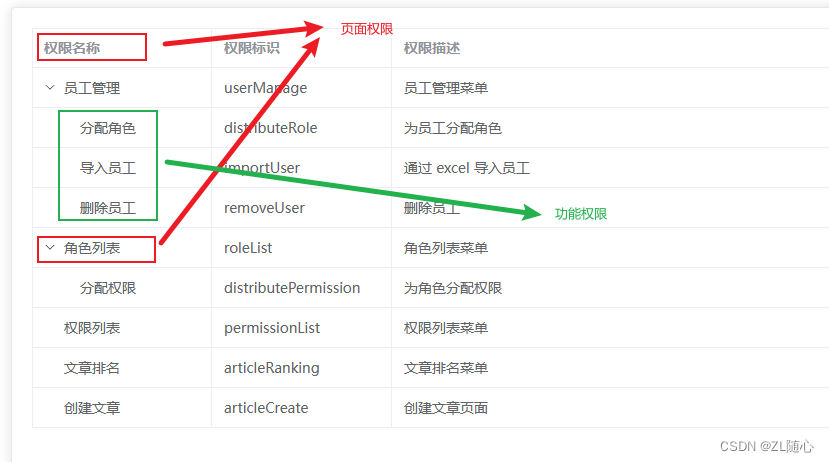
需要定义一个指令即可
import store from '@/store'
function checkPermission(el, binding) {
// 获取绑定的值,此处为权限
const { value } = binding
// 获取所有的功能指令
const points = store.getters.userInfo.permission.points
// 当传入的指令集为数组时
if (value && value instanceof Array) {
// 匹配对应的指令
const hasPermission = points.some(point => {
return value.includes(point)
})
// 如果无法匹配,则表示当前用户无该指令,那么删除对应的功能按钮
if (!hasPermission) {
el.parentNode && el.parentNode.removeChild(el)
}
} else {
// eslint-disabled-next-line
throw new Error('v-permission value must be ["admin","editor"]')
}
}
export default {
// 在绑定元素的父组件被挂载后调用
mounted(el, binding) {
checkPermission(el, binding)
},
// 在包含组件的 VNode 及其子组件的 VNode 更新后调用
update(el, binding) {
checkPermission(el, binding)
}
}
然后全局注册一下指令即可,然后在用的地方
import permission from './permission'
app.directive('permission', permission)然后在使用的地方像下面这样使用即可
<el-button
v-permission="['edit']"
>
5.3、1element-plus table 动态列 与 拖拽行
3.1、动态列
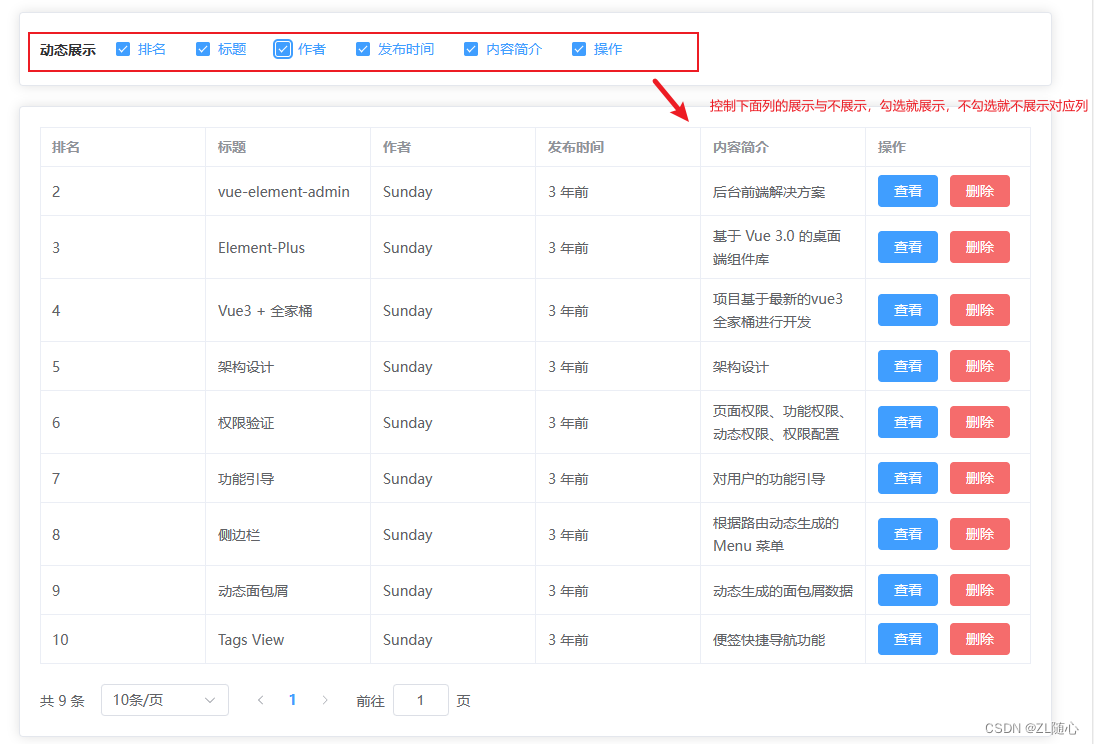
其实主要就是涉及三块数据源
1、动态展示哪里用于展示的数据 这里称为 dynamicData
2、选中的数据 这里称为 selectDynamicLabel
3、根据 selectDynamicLabel 在 dynamicData过滤 出来的数据这里称为 tableColumns (也就是用于表格列展示的)
页面代码
<template>
<div class="article-ranking-container">
<el-card class="header">
<div class="dynamic-box">
<span class="title">{{ $t('msg.article.dynamicTitle') }}</span>
<el-checkbox-group v-model="selectDynamicLabel">
<el-checkbox
v-for="(item, index) in dynamicData"
:label="item.label"
:key="index"
>{{ item.label }}</el-checkbox
>
</el-checkbox-group>
</div>
</el-card>
<el-card>
<el-table ref="tableRef" :data="tableData" border>
<el-table-column
v-for="(item, index) in tableColumns"
:key="index"
:prop="item.prop"
:label="item.label"
>
<template #default="{ row }" v-if="item.prop === 'publicDate'">
{{ $filters.relativeTime(row.publicDate) }}
</template>
<template #default="{ row }" v-else-if="item.prop === 'action'">
<el-button type="primary" size="mini" @click="onShowClick(row)">{{
$t('msg.article.show')
}}</el-button>
<el-button type="danger" size="mini" @click="onRemoveClick(row)">{{
$t('msg.article.remove')
}}</el-button>
</template>
</el-table-column>
</el-table>
<el-pagination
class="pagination"
@size-change="handleSizeChange"
@current-change="handleCurrentChange"
:current-page="page"
:page-sizes="[5, 10, 50, 100, 200]"
:page-size="size"
layout="total, sizes, prev, pager, next, jumper"
:total="total"
>
</el-pagination>
</el-card>
</div>
</template>
<script setup>
import { ref, onActivated } from 'vue'
import { getArticleList } from '@/api/article'
import { watchSwitchLang } from '@/utils/i18n'
import { dynamicData, selectDynamicLabel, tableColumns } from './dynamic'
import { tableRef, initSortable } from './sortable'
// 数据相关
const tableData = ref([])
const total = ref(0)
const page = ref(1)
const size = ref(10)
// 获取数据的方法
const getListData = async () => {
const result = await getArticleList({
page: page.value,
size: size.value
})
tableData.value = result.list
total.value = result.total
}
getListData()
// 监听语言切换
watchSwitchLang(getListData)
// 处理数据不重新加载的问题
onActivated(getListData)
/**
* size 改变触发
*/
const handleSizeChange = (currentSize) => {
size.value = currentSize
getListData()
}
/**
* 页码改变触发
*/
const handleCurrentChange = (currentPage) => {
page.value = currentPage
getListData()
}
// 表格拖拽相关
onMounted(() => {
initSortable(tableData, getListData)
})
</script>
<style lang="scss" scoped>
.article-ranking-container {
.header {
margin-bottom: 20px;
.dynamic-box {
display: flex;
align-items: center;
.title {
margin-right: 20px;
font-size: 14px;
font-weight: bold;
}
}
}
:deep(.el-table__row) {
cursor: pointer;
}
.pagination {
margin-top: 20px;
text-align: center;
}
}
:deep(.sortable-ghost) {
opacity: 0.6;
color: #fff !important;
background: #304156 !important;
}
</style>
处理动态列逻辑的代码
import getDynamicData from './DynamicData'
import { watchSwitchLang } from '@/utils/i18n'
import { watch, ref } from 'vue'
// 暴露出动态列数据
export const dynamicData = ref(getDynamicData())
// 监听 语言变化
watchSwitchLang(() => {
// 重新获取国际化的值
dynamicData.value = getDynamicData()
// 重新处理被勾选的列数据
initSelectDynamicLabel()
})
// 创建被勾选的动态列数据
export const selectDynamicLabel = ref([])
// 默认全部勾选
const initSelectDynamicLabel = () => {
selectDynamicLabel.value = dynamicData.value.map(item => item.label)
}
initSelectDynamicLabel()
// 声明 table 的列数据
export const tableColumns = ref([])
// 监听选中项的变化,根据选中项动态改变 table 列数据的值
watch(
selectDynamicLabel,
val => {
tableColumns.value = []
// 遍历选中项
const selectData = dynamicData.value.filter(item => {
return val.includes(item.label)
})
tableColumns.value.push(...selectData)
},
{
immediate: true
}
)
列的数据源的代码
import i18n from '@/i18n'
const t = i18n.global.t
// 这样,当国际化改变的时候,才能跟随改变
export default () => [
{
label: t('msg.article.ranking'),
prop: 'ranking'
},
{
label: t('msg.article.title'),
prop: 'title'
},
{
label: t('msg.article.author'),
prop: 'author'
},
{
label: t('msg.article.publicDate'),
prop: 'publicDate'
},
{
label: t('msg.article.desc'),
prop: 'desc'
},
{
label: t('msg.article.action'),
prop: 'action'
}
]
3.2、拖拽行
安装sorttablejs
npm i sortablejs排序逻辑处理
import { ref } from 'vue'
import Sortable from 'sortablejs'
import { articleSort } from '@/api/article'
import i18n from '@/i18n'
// 排序相关
export const tableRef = ref(null)
/**
* 初始化排序
* tableData: 表格数据
* cb:重新获取列表数据
*/
export const initSortable = (tableData, cb) => {
// 设置拖拽效果
const el = tableRef.value.$el.querySelectorAll(
'.el-table__body tbody'
)[0]
// 1. 要拖拽的元素
// 2. 配置对象
Sortable.create(el, {
// 拖拽时类名,就是控制拖拽行的颜色
ghostClass: 'sortable-ghost',
// 拖拽结束的回调方法
async onEnd(event) {
const { newIndex, oldIndex } = event
// 修改数据
await articleSort({
// 获取对应数据的排名
initRanking: tableData.value[oldIndex].ranking,
finalRanking: tableData.value[newIndex].ranking
})
ElMessage.success({
message: i18n.global.t('msg.article.sortSuccess'),
type: 'success'
})
// 直接重新获取数据无法刷新 table!!
tableData.value = []
// 重新获取数据
cb && cb()
}
})
}
使用的地方
// 表格拖拽相关
onMounted(() => {
initSortable(tableData, getListData)
})6、markdown与富文本
这里会使用到两个库,这稍微讲一下怎么选择我们的库
- 开源协议最好是BSM、MIT的
- start最好是10k以上的(5k也行)
- 关注上一个版本发布时间不能间隔太久
- 关注issue是否有及时回应
- 文档是否详尽,最好有中文文档了
markdown 编辑器:tui.editor
富文本编辑器:wangEditor
6.1、markdown

安装
npm i @toast-ui/editor@3.0.2基本使用
// 绑定一个html
<div id="markdown-box"></div>
// 逻辑处理
import MkEditor from '@toast-ui/editor'
import '@toast-ui/editor/dist/toastui-editor.css'
import '@toast-ui/editor/dist/i18n/zh-cn'
let mkEditor
let el
onMounted(() => {
el = document.querySelector('#markdown-box')
initMkEditor()
})
const initMkEditor = () => {
mkEditor = new MkEditor({
el,
height: '500px',
previewStyle: 'vertical',
language: store.getters.language === 'zh' ? 'zh-CN' : 'en'
})
mkEditor.getMarkdown()
}
// 涉及markdown 销毁相关的
const htmlStr = mkEditor.getHTML()
mkEditor.destroy()
initMkEditor()
mkEditor.setHTML(htmlStr)6.2、富文本
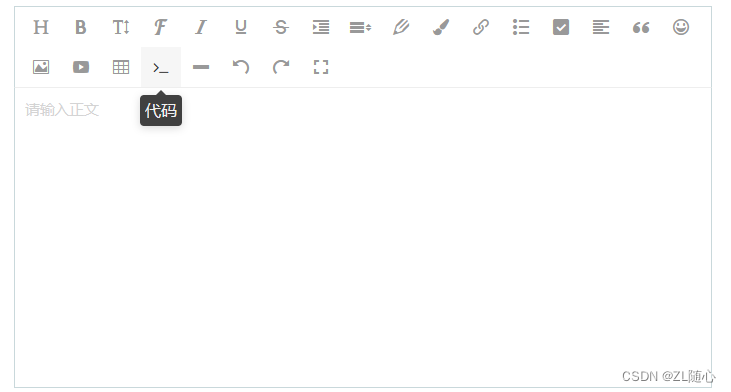
安装
npm i wangeditor@4.7.6基本逻辑使用
// html
<div id="editor-box"></div>
// 引入库
import E from 'wangeditor'
// 基本逻辑处理
// Editor实例
let editor
// 处理离开页面切换语言导致 dom 无法被获取
let el
onMounted(() => {
el = document.querySelector('#editor-box')
initEditor()
})
const initEditor = () => {
editor = new E(el)
editor.config.zIndex = 1
// // 菜单栏提示
editor.config.showMenuTooltips = true
editor.config.menuTooltipPosition = 'down'
editor.create()
}
// 内容通过html展示
editor.txt.html(val.content)7、数据可视化
7.1、可视化解读
可视化其实分为,大可视化与数据可视化,大屏可视化通常是自己自成一个项目,而数据可视化则是一般集成在我们的后台管理系统里面,他们都是为了让我们数据可以通过图标的方式比较直观的查看,而可视化的解决方案主要有两种,AntV与Echarts
7.2、countUp的使用
countUp主要是用于数据变化的时候时期具有动画效果
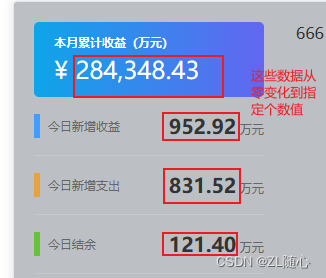
7.3、文字云图
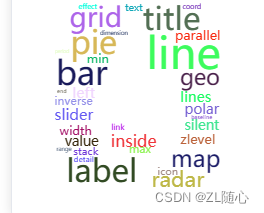
通过echarts 和 echarts-wordcloud实现
8、项目部署
1、为什么需要打包?
答: 为了让浏览器识别
2、浏览器可以直接通过url访问打包后的项目嘛?
答:不行,通过打包后的index.html 直接打包,会报文件找不到模块的错误
3、为啥需要服务器?
答:为了避免出现找不到模块的错误,所以需要一个服务器,把模块都放到服务器上
8.1、电脑访问网页图解
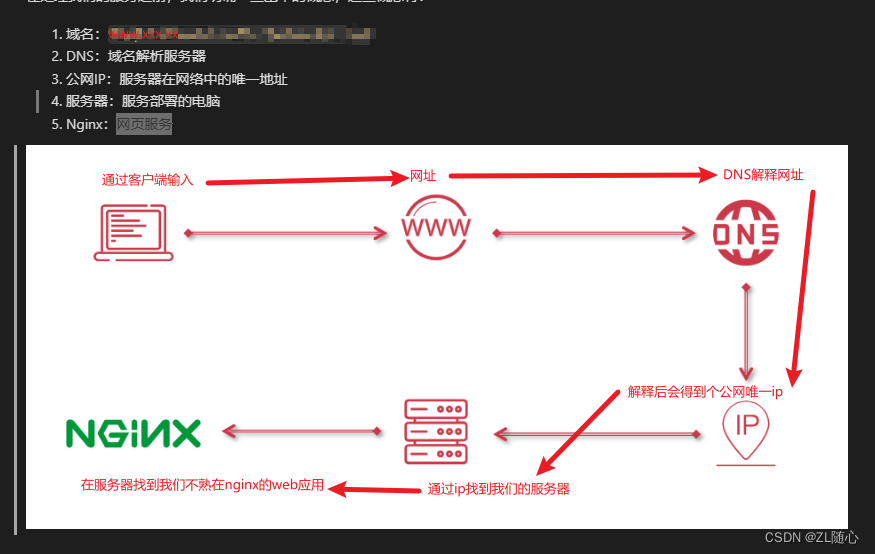
8.2、服务器购买
常见的链接服务器的方式
- 阿里云控制台中进行远程链接
- 通过
SSH工具(XShell) SSH指令远程登录
8.3、Xshell连接服务器可以使用
1、新建会话
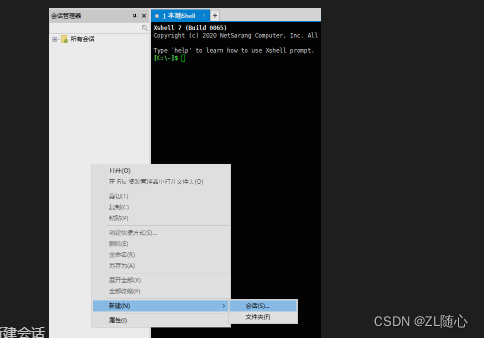
2、确定会话信息,协议为 SSH、主机为服务器 IP(也就是我们购买的服务器)、端口号为 22
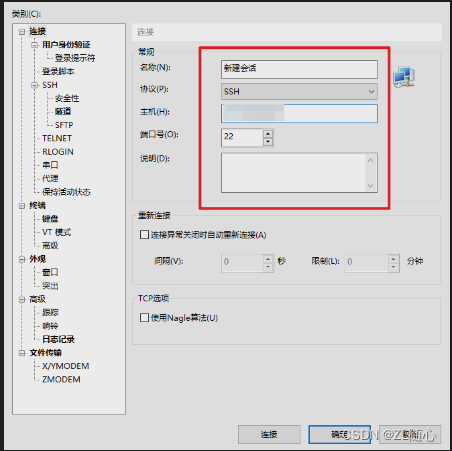
3、确定之后就会看到我们的会话列表
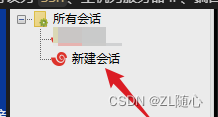
4、双击我们的会话列表中的会话,然后输入用户名(默认用户名是root)

5、输入你的密码
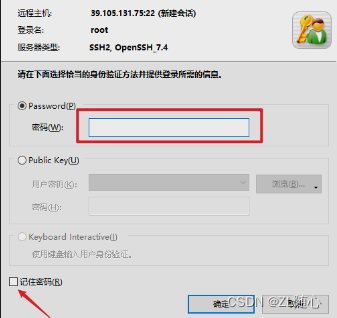
6、出现下面信息表示连接成功

8.4、配置nginx
1、nginx 编译时依赖 gcc 环境
yum -y install gcc gcc-c++2、安装 prce,让 nginx 支持重写功能
yum -y install pcre*3、安装 zlib,nginx 使用 zlib 对 http 包内容进行 gzip 压缩
yum -y install zlib zlib-devel 4、安装 openssl,用于通讯加密
yum -y install openssl openssl-devel5、下载 nginx 压缩包
wget https://nginx.org/download/nginx-1.11.5.tar.gz6、解压 nginx
tar -zxvf nginx-1.11.5.tar.gz7、进入 nginx-1.11.5 目录
cd nginx-1.11.58、检查平台安装环境
./configure --prefix=/usr/local/nginx9、进行源码编译
make 10、安装 nginx
make install11、查看 nginx 配置
/usr/local/nginx/sbin/nginx -t12、制作nginx 软连接,进入 usr/bin 目录
cd /usr/bin13、制作软连接
ln -s /usr/local/nginx/sbin/nginx nginx14、首先打开 nginx 的默认配置文件中
vim /usr/local/nginx/conf/nginx.conf15、在最底部增加配置项(按下 i 进入 输入模式)
include /nginx/*.conf;16、按下 esc 键,通过 :wq! 保存并退出
17、创建新的配置文件
touch /nginx/nginx.conf18、打开 /root/nginx/nginx.conf 文件
vim /nginx/nginx.conf19、写入如下配置
# nginx config
server {
# 端口 根据实际情况来
listen 8081;
# 域名 申请的时候是啥就些啥就可以了 比如 http://www.xx.xx.yy
server_name localhost;
# 资源地址
root /nginx/dist/;
# 目录浏览
autoindex on;
# 缓存处理
add_header Cache-Control "no-cache, must-revalidate";
# 请求配置
location / {
# 跨域
add_header Access-Control-Allow-Origin *;
# 返回 index.html
try_files $uri $uri/ /index.html;
}
}20、通过 :wq! 保存退出
21、在 root/nginx 中创建 dist 文件夹
mkdir /nginx/dist22、在 nginx/dist 中写入 index.html 进行测试,也就是创建一个index.html文件,然后随便写入一些东西,然后保存

23、通过 nginx -s reload 重启服务
24、在 浏览器中通过,IP 测试访问,看能不能访问到我们的index.html中的内容
25、将我们 npm run build 打包后的dist下的所有文件传入到我们上面的dist目录下
可以通过 XFTP 进行传输
26、之后我们就可以通过我们申请的域名进行访问我们的项目了
原文地址:https://blog.csdn.net/weixin_44832362/article/details/136634274
免责声明:本站文章内容转载自网络资源,如本站内容侵犯了原著者的合法权益,可联系本站删除。更多内容请关注自学内容网(zxcms.com)!
